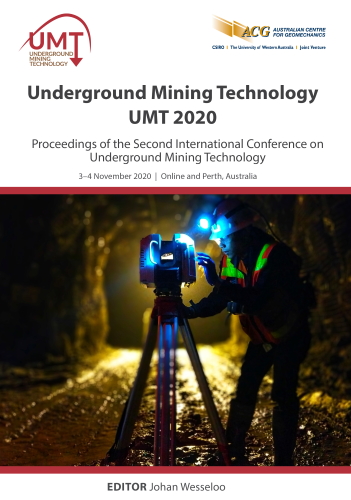Efficient paste mix designs using new generation backfill admixtures: perception versus reality

|
Authors: Erismann, F; Hansson, M |
DOI https://doi.org/10.36487/ACG_repo/2035_07
Cite As:
Erismann, F & Hansson, M 2020, 'Efficient paste mix designs using new generation backfill admixtures: perception versus reality', in J Wesseloo (ed.), UMT 2020: Proceedings of the Second International Conference on Underground Mining Technology, Australian Centre for Geomechanics, Perth, pp. 207-216, https://doi.org/10.36487/ACG_repo/2035_07
Abstract:
Backfilling mined out stopes with cemented paste has become the standard in most modern, long-hole stoping and cut-and-fill operations globally. The implementation of large-scale paste production plants and efficient underground paste reticulation systems contributed significantly to maximised ore extraction, higher levels of mine-scale geotechnical stability, larger degree of automation and last, but not least, to a more conscious management of mine processing waste. However, paste backfilling comes at a cost. Binder costs alone amount to 70–80% of total operating costs of paste plants depending on the strength requirements and characteristics of tailings used for backfilling and it is not uncommon that underground paste filling contributes up to 20% of the overall cost structure of an underground operation. With a view towards improving the paste mix designs and keeping cement consumption under control, new generation paste backfill admixtures have been developed over the past years. The mine backfill industry can be compared to the concrete industry 40 years ago, when high performance admixtures started to emerge for landmark projects, where exceptionally high concrete qualities and specific, fresh concrete properties were required (Aitcin & Wilson 2015). These high range water reducers quickly transformed the construction industry and pushed concrete applications to new, previously unknown limits. This paper intends to give an overview of the reality of admixtures in the mine backfill industry and their performance and justification in modern paste backfill plants with pump driven reticulation systems. Data from different paste plants around the globe has been compiled for this study, covering different deposit types, strength requirements and pumped paste mix designs. The study illustrates the powerful effect paste backfill admixtures can have on standard paste mix designs and their potential to reduce binder consumption substantially by remaining within the required strength and workability limits of the paste to improve the overall cost structure of backfill operations.
Keywords: paste fill, admixtures, binder, optimisation, mining, backfill, early strength, cycle time, efficiency, sika, mining, underground, rapid development, cement saving, cement reduction, cost performance, mix
References:
Aitcin, P & Flatt, R 2016, Science and Technology of Concrete Admixtures, Woodhead Publishing, Cambridge, p. xxi.
Aitcin, P & Wilson, W 2015, ‘The sky’s the limit’, Concrete International, vol. 37, issue 1, pp. 53–58.
Bakken, B & Einaudi, M 1986, ‘Spatial and temporal relations between wall rock alteration and gold mineralization, main pit, Carlin gold mine, Nevada, U.S.A’, in A Macdonald, A (ed.), Proceedings of Gold '86, an International Symposium on the Geology of Gold, Geological Association of Canada, St. John’s, pp. 388–403.
Erismann, F, Kurz, C & Hansson, M 2016, ‘The benefits of incorporating admixtures into mine paste backfill’, in S Barrera & R Jewell (eds), Proceedings of the 19th International Seminar on Paste and Thickened Tailings, Gecamin, Santiago, pp. 76–86.
Hausen, D & Kerr, P 1968, ‘Fine gold occurrence at Carlin, Nevada’, in J Ridge (ed.), Ore Deposits of the United States, 1933-1967, The Graton-Sales Volume, The American Institute of Mining, Metallurgical, and Petroleum Engineers, Inc., New York, pp. 908–940.
McKibben, M & Hardie, L 1997, ‘Ore-forming brines in active continental rifts’, in HL Barnes (eds), Geochemistry of Hydrothermal Ore Deposits, Wiley Interscience, New York, pp. 877–930.
Partington, C & Williams, P 2000, ‘Proterozoic lode gold and (iron)-copper-gold deposits: a comparison of Australian and global examples’, Reviews in Economic Geology, vol. 13, pp. 69–101.
Radtke, A, Rye, R & Dickson, F 1980, ‘Geology and stable isotope studies of the Carlin gold deposit, Nevada’, Economic Geology, vol. 75, pp. 641–672.
Ramachandran, V, Malhotra, V, Jolicoeur, C & Spiratos, N 1998, Superplasticizers. Properties and Applications in Concrete, Materials Technology Laboratory, CANMET, Ottawa.
Silva, M 2017, Contribution to Laboratorial Determination of Rheological Properties of Paste Backfill, Zinkgruvan and Neves-Corvo Case Studies, MSc thesis, Technico Lisboa, Lisbon.
Sofra, F 2017, ‘Rheological properties of fresh cemented paste tailings’, in E Yilmaz & M Fall (eds), Paste Tailings Management, Springer, Cham, pp. 33–57.
© Copyright 2024, Australian Centre for Geomechanics (ACG), The University of Western Australia. All rights reserved.
View copyright/legal information
Please direct any queries or error reports to repository-acg@uwa.edu.au
View copyright/legal information
Please direct any queries or error reports to repository-acg@uwa.edu.au
